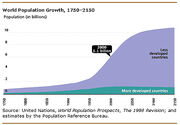Nature is in a constant state of disequilibrium caused by the continual flow of energy from the sun. This disequilibrium is exemplified by changes in the stores of natural capital. Carbon flows unevenly and unpredictably between plants, animals, atmosphere and oceans. Populations grow or decline depending on the availability of resources and the presence or absence of predators. These changes are largely unpredictable and regulated by feedback mechanisms. To understand how these mechanisms work we first need to look in more detail at growth.
Exponential growth: Rani’s tale[]
A long time ago in India a raja demands that his villagers turn over almost all their rice for safe storage, leaving them just enough to get by on. When a year of drought arrives, famine and hunger ensue and his people beg him to release some of the rice from the royal store but he refuses. As his people become more and more famished, the Raja decides to have a feast at his court. As a parade of elephants returns from the royal storehouses loaded down with sacks of rice, Rani, a clever village girl, walks behind them, collecting falling rice in her skirt. When she is caught she explains that she is collecting the rice to return to the Raja. The Raja, striving to be wise and fair, decides to reward her for returning his rice. He tells Rani: “Ask me for anything and you shall have it.” To the Raja’s surprise, Rani asks for just one grain of rice. When the Raja says that is not enough of a reward, she acquiesces and asks that he give her one grain of rice on the first day, then each day, for the following 30 days, he is to give her double the rice he gave her the day before. The Raja considers this to be a modest request and readily agrees. By the end of the 30 days, Rani has more than a billion grains of rice and the Raja has no more to give. The Raja, having learned an important lesson both about maths and about fairness, promises to only take as much rice as he needs from now on.
http://www.watersfoundation.org/index.cfm?fuseaction=content.display&id=93
You can see why the Raja so readily agreed to Rani’s request. In the early days the effect on his store is almost unnoticeable. As the graph shows, reinforcing (positive) feedback sets off a doubling pattern that starts slowly but builds up to an explosive climax. These positive feedback loops are everywhere in nature.
===Reinforcing Feedback ===

http://www.watersfoundation.org/index.cfm?fuseaction=content.display&id=93
Feedback describes the situation when output from an event in the past will influence the same event in the present or future. You can see from this example above how Rani’s next delivery by the Raja is determined by the rice last received from the Raja. Each time Rani’s delivery doubles from 1 to 2 to 4 to 8 to 16 to 36 and so on until by the 30th doubling Rani has actually accumulated more than one billion grains of rice. This type of exponential growth, triggered by reinforcing feedback is widespread in nature and accounts for the flourishing of micro-organisms on a fresh substrate – SARS virus spreading through a community and current world population growth.
Stabilising feedback[]
In most cases, unrestrained exponential growth like that illustrated in Rani’s tale cannot continue indefinitely. Often the system will crash, for example the Raja’s barn store runs out of rice. Alternatively, stabilising feedback

Stabilizing Feedback
mechanisms slow down the rate of growth. For instance, microbe growth slows down then reverses as nutrients become scarcer and toxic wastes begin to accumulate.
The world population is currently growing exponentially driven by reinforcing feedback. This suggests that there is a need for an exponential increase in most resources, including food, water and metals. Coupled with this is the exponential increase in waste production and loss of natural capital. How stabilising feedback mechanisms can be more actively employed to impact on unsustainable growth is a key to understanding a circular economy.

Equilibrium[]
Most natural systems do not have straightforward cause-and-effect relationships. Imagine a vessel containing two reversible chemical reactions. Suppose reacting chemicals A and B produces products C and D. Eventually the rates of the two reactions will become equal. A and B will be converting into C and D at exactly the same rate as C and D convert back into A and B.

At this point there won’t be any further change in the amounts of A, B, C and D in the mixture. As fast as something is being removed, it is being replaced again by the reverse reaction. We have reached a position of dynamic equilibrium. But most systems found in nature are not in thermodynamic equilibrium because they are changing over time and are subject to flux of matter and energy to and from other systems. A better chemical model is demonstrated in the Belousov Zhabotinsky reaction in which the chemical mixture containing two reversible reactions oscillates spontaneously from red to blue and back again. The mixture exhibits local variations in colour depending on temperature or stirring. This reaction better demonstrates the way that nature changes. It is the flow of sunshine that moves water between the ocean and the sky, makes the wind blow and raises plants from the soil.